|
The apparatus of the "Transair" type are medical devices of new generation. They are designated for the treatment of diseases by the way of activation of the own brain defense mechanisms.
The electrostimulation is non-invasively performed through electrodes placed on the skin of a forehead and mastoids. Operating conditions of the apparatus provide the selective influence of the
special mode of the weak current on the brain opioid structures. As a result, the levels of endorphins increase in 5-10 min from the beginning of the stimulation. Endorphins are important internal matters,
which regulate homeostasis and elicit of analgesia, accelerate tissue repair, stimulate immunity etc. This fact causes a complex display of curative effects.
  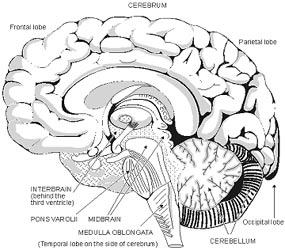
The effects of a new non-invasive method of transcranial electrostimulation (TES):
1) TES activated some specific and nonspecific mechanisms of resistivity and immunity. According these effects TES inhibited implanted tumor growth and it is a basis of
TES usage for non-pharmaceutical analgesia in onco-logical patients with metastasis.
2) TES accelerated repair of damaged tissu-es and used for treatment wounds and thermal burns, ulcers, myocardial infarction, sensorineural deafness, toxic hepatosis.
3) Bloodpressure normalization based on experimentally revealed of TES endorphinergic effect on medulla vasomotor center used treatment of hypertension and vasomotor dystonia
especially during preclimax.
4) Analgesic effects broadly studied in screening experiments (see above) were practically used for relief of neurological and other types of pain syndromes and were more pronounced
in cases of heavy pain (trigeminal neuralgia, postoperative pain). To exclude the morphine-like analgesic consumption TES was included as analgesic component of anesthesia during surgery.
5) TES of the brain endorphinergic structures reduced of abstinence, craving and other affective disorders connected with alcohol and opioid drug abuse.
6) Psycho-physiological effects only was estimated in healthy volunteers (several tests, questionnaires and computerized hart rate variability) manifested in reduction of fatigue,
affectivity and stress events, increase of mood and adaptability. In general in different groups of patients treated by TES the increase of the "quality of life" and reduction of depression
were observed. Preliminary studies demonstrated the obvious positive TES effects in treatment of the "chronic fatigue" syndrome in adults and pathological hyperactivity in children.
TES devices were developed according "quasiresonance" peculiari-ties of the brain antinociceptive system. It means that it is not necessary to adjust the frequency and impulse width for concrete case.
Nevertheless the frequency and impulse width stochastically change of its values inside the limits of quasiresonance curves (± 2 Hz and ± 0.25 msec respectively).
To reduce the local unpleasant filling under electrodes the non-symmetrical bipolar impulses with zero net charge are use.
Several models of devices with generic name as TRANSAIR (abbreviations of Transcranial Stimulator for Analgesia, Immunity, Repair) for therapeutics and anesthesiological applications were
developed and are manufactured by TES Center of the Pavlov Institute of Physiology.
THE FIELD OF APPLICATION
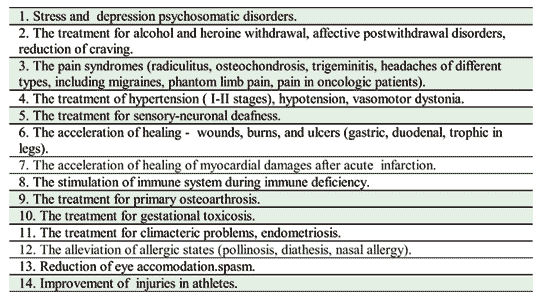
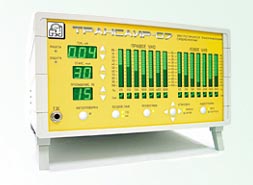  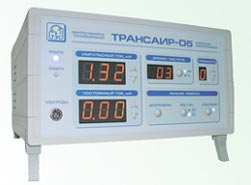  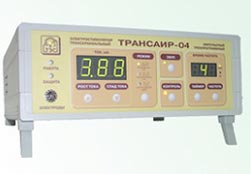
TRANSAIR 07 TRANSAIR 05 TRANSAIR 05  TRANSAIR 04 TRANSAIR 04
  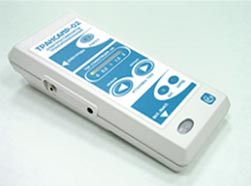
TRANSAIR 02
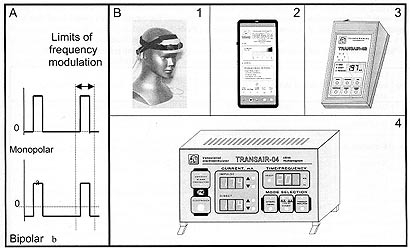
Fig. 1. Output current impulses (A) of TES devices (B).
A. Shape of impulses and limits of frequency modulation.
B. Different TRANSAIR models.
1- Headset of electrodes.
2- TRANSAIR - 02, the simpliest for outdoor usage, monopolar output impulse, rechargeable battery.
3- TRANSAIR - 01, for practitioners, mono- and bipolar out put impulses, LCD, timer, frequency control, alarm and protection systems, plug in.
4- TRANSAIR - 04, for hospitals and outpatients clinics, mono- and bipolar output impulses with or without frequency modulation,
LD indicators, timer, automatic control, alarm and protection systems, verbal dialogue with user in process of adjustment of parameters, plug in.
|